Given
Speed of first aeroplane = 1000 km/hr
Distance covered by first aeroplane flying due north in
$1\dfrac{1}{2}$ hours (OA) = 1000 × $\dfrac{3}{2}$ km = 1500 km
Speed of second aeroplane = 1200 km/hr
Distance covered by second aeroplane flying due west in
$1\dfrac{1}{2}$ hours (OB) = 1200 × $\dfrac{3}{2}$ km = 1800 km

In right angle ΔAOB, by Pythagoras Theorem,
AB^2 = AO^2 + OB^2
AB2 = $(1500)^2 + (1800)^2$
AB = $\sqrt{(2250000 + 3240000)}$
= $\sqrt{5490000}$
AB = 300$\sqrt{61}$ km
Hence, the distance between two aeroplanes will be 300 $\sqrt{61}$ km.
Given, Two poles of heights 6 m and 11 m stand on a plane ground.
And distance between the feet of the poles is 12 m.
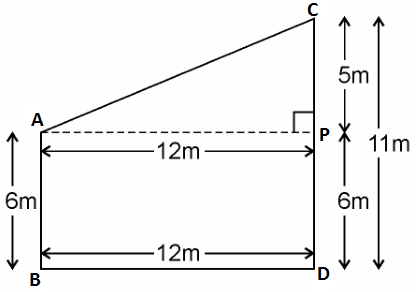
Let AB and CD be the poles of height 6m and 11m.
Therefore, CP = 11 – 6 = 5m
From the figure, it can be observed that AP = 12m
By Pythagoras theorem for ΔAPC, we get,
$AP^2 = PC^2 + AC^2$
$(12m)^2 + (5m)^2 = (AC)^2$
$AC^2 = (144+25) m^2 = 169 m^2$
AC = 13m
Therefore, the distance between their tops is 13 m.
Given, D and E are points on the sides CA and CB respectively of a triangle ABC right angled at C.
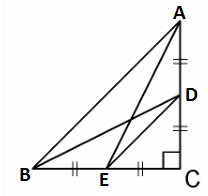
By Pythagoras theorem in ΔACE, we get
$AC^2 + CE^2 = AE^2$ ………………………………………….(i)
In ΔBCD, by Pythagoras theorem, we get
$BC^2 + CD^2 = BD^2$ ………………………………..(ii)
From equations (i) and (ii), we get,
$AC^2 + CE^2 + BC^2 + CD^2 = AE^2 + BD^2$ …………..(iii)
In ΔCDE, by Pythagoras theorem, we get
$DE^2 = CD^2 + CE^2$
In ΔABC, by Pythagoras theorem, we get
$AB^2 = AC^2 + CB^2$
Putting the above two values in equation (iii), we get
$DE^2 + AB^2 = AE^2 + BD^2$
The perpendicular from A on side BC of a Δ ABC intersects BC at D such that DB = 3 CD (see Fig. 6.55). Prove that $2 AB^2 = 2 AC^2 + BC2$
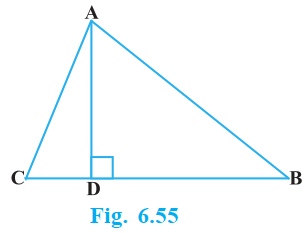
Given, the perpendicular from A on side BC of a Δ ABC intersects BC at D such that
DB = 3CD
In Δ ABC
AD $\perp$ BC and BD = 3CD
In right angle triangle, ADB and ADC, by Pythagoras theorem,
$AB^2 = AD^2 + BD^2$ ……………………….(i)
$AC^2 = AD^2 + DC^2 $……………………………..(ii)
Subtracting equation (ii) from equation (i), we get
$AB^2 – AC^2 = BD^2 – DC^2$
= $9CD^2 – CD^2$ [Since, BD = 3CD]
= $8CD^2$
= $8(\dfrac{BC}{4})^2$ [Since, BC = DB + CD = 3CD + CD = 4CD]
Therefore, $AB^2 – AC^2 = \dfrac{BC^2}{2}$
$2(AB^2 – AC^2) = BC^2$
$2AB^2 – 2AC^2 = BC^2$
$2AB^2 = 2AC^2 + BC^2$
Given, ABC is an equilateral triangle
And D is a point on side BC such that BD = $\dfrac{1}{3BC}$
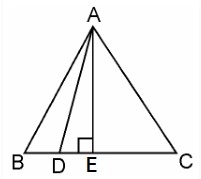
Let the side of the equilateral triangle be a, and AE be the altitude of ΔABC
BE = EC = $\dfrac{BC}{2} = \dfrac{a}{2}$
And, AE = $a\dfrac{\sqrt{3}}{2}$
Given, BD = $\dfrac{1}{3BC}$
BD =$\dfrac{a}{3}$
DE = BE – BD = $\dfrac{a}{2} – \dfrac{a}{3} = \dfrac{a}{6}$
In ΔADE, by Pythagoras theorem
$AD^2 = AE^2 + DE^2$
$AD^2 = (\dfrac{a\sqrt{3}}{2})^2 + (\dfrac{a}{6})^2$
$AD^2 = \dfrac{3a^2}{4} + \dfrac{a^2}{36}$
$AD^2 = \dfrac{28a^2}{36}$
$AD^2 = \dfrac{7}{9} AB^2$
$9 AD^2 = 7 AB^2$
Given, an equilateral triangle say ABC
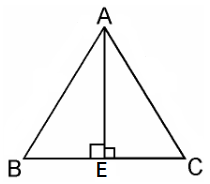
Let the sides of the equilateral triangle be of length a, and AE be the altitude of ΔABC
BE = EC = $\dfrac{BC}{2} = \dfrac{a}{2}$
In ΔABE, by Pythagoras Theorem, we get
$AB^2 = AE^2 + BE^2$
$a^{2}= AE^{2}+(\dfrac{a}{2})^2$
$AE^{2}=a^{2}-\dfrac{a^2}{4}$
$AE^{2}= \dfrac{3a^2}{4}$
$4AE^2 = 3a^2$
4 × (Square of altitude) = 3 × (Square of one side)
Hence, proved.
Given, in ΔABC, AB = 6 $\sqrt{3}$ cm, AC = 12 cm and BC = 6 cm.
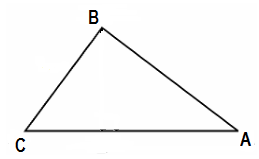
We can observe that,
$AB^2 $= 108
$AC^2$ = 144
And, $BC^2$= 36
$AB^2 + BC^2 = AC^2$
The given triangle, ΔABC, is satisfying Pythagoras theorem.
Therefore, the triangle is a right triangle, right-angled at B.
$\angle B = 90°$
Hence, the correct answer is (C).
